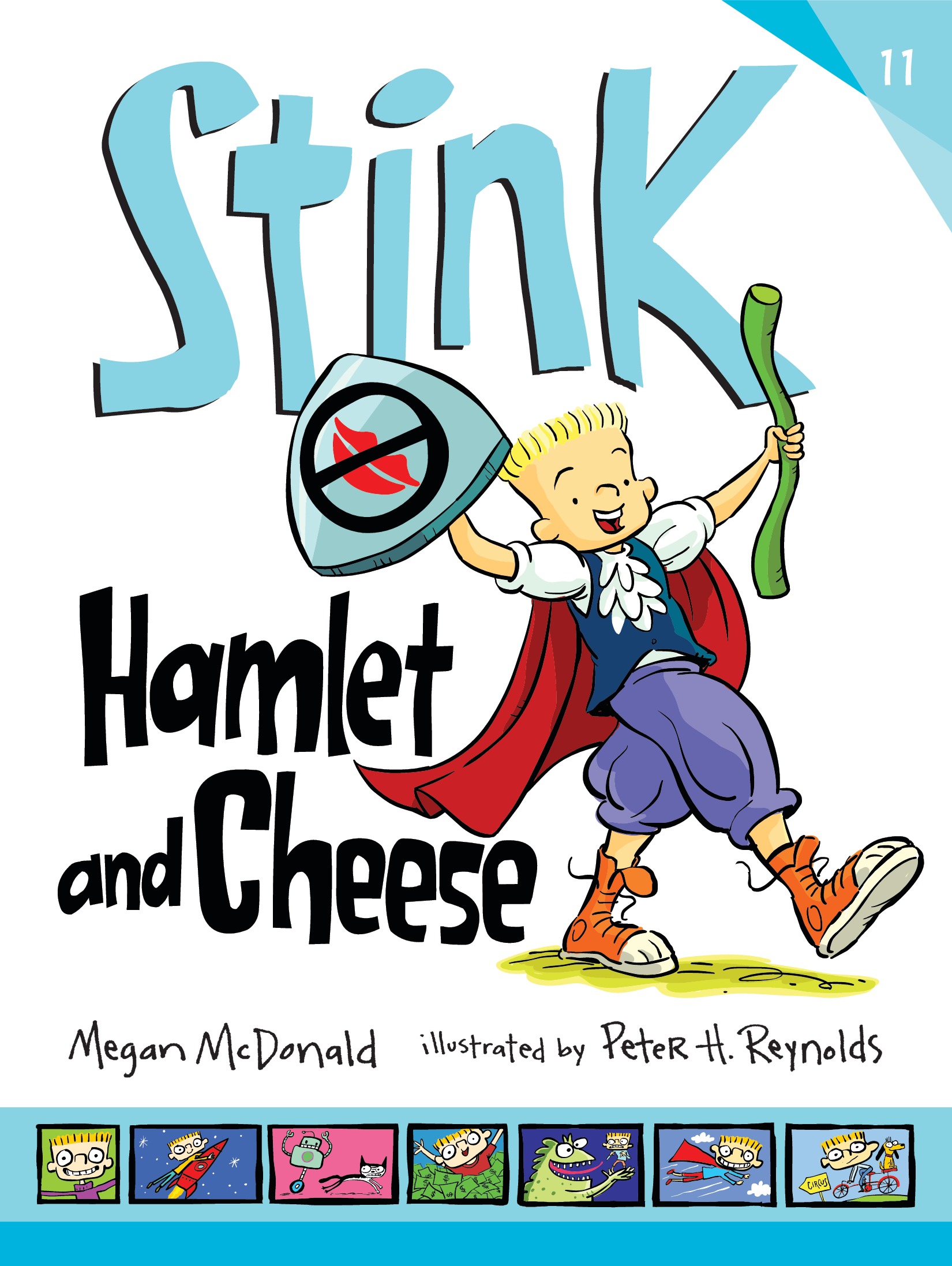| ________________
CM . . .
. Volume XXIV Number 28. . . .March 23, 2018

 |
Stink: Hamlet and Cheese. (Stink, Bk. 11).
Megan McDonald. Illustrated by Peter H. Reynolds.
Somerville, MA: Candlewick Press (Distributed in Canada by Random House of Canada), 2018.
124 pp., hardcover, $18.99.
ISBN 978-0-7636-9163-9.
Grades 2-5 / Ages 7-10.
Review by Elaine Fuhr.
***½ /4
Reviewed from Advance Reading Copy.
|
| |
|

Excerpt:
Amanda Beth taught them how to make faces: sad faces, mad faces, glad faces. Stink practiced his best cuckoo-crazy face on Riley.
Riley made fishy lips. Smooch, smooch. She made kissy sounds.
“Gross!” Stink jumped up and grabbed a toilet brush from the props box. He jabbed it in front of him like a pretend sword. “Back, back, you fiend, or it’s Curse of the Toilet Brush for you.”
“Guess what? There is a lot of kissing in Shakespeare.”
“Nah-uh,” said Stink. “There’s a lot of sword fights and stabbing. Amanda Beth didn’t say anything about--”
“Shakespeare’s most famous play is Romeo and Juliet,” said Riley in her know-it-all voice. “Romeo and Juliet are big-time in love. O Romeo, Romeo.”
Riley chased after Stink, but he fended her off with the toilet brush.
“Death to Smoochy!” yelled Stink.
...
Too bad Amanda Beth waited until the end of the day to teach them about Shakespeare insults! “Shakespeare’s plays,” she told them, “have a lot of colorful words. When a person gets mad or calls someone else a name, the things they say might sound funny to our ears. I’ll show you what I mean.”
Amanda Beth passed out a list of strange sounding words. “Use words from each column to make funny sounding insults. Take these sheets home and practice, because we’ll be using our insults later this week.”
It’s Spring Break, and all Stink’s friend, Sophie, can talk about is Shakespeare camp. It sounds just too good to pass up with costumes, sword fights, murders and all kinds of interesting characters. Amanda Beth, leader of the camp, explains what they will do and tells them some interesting facts. Stink is the only boy in camp, but, in Shakespeare’s time, girls were not allowed to act, and so boys played all the female roles in the plays. They wore long fancy dresses, wigs and crowns. Amanda Beth explains that, by the end of the week, they will present a portion of one of the plays to parents, but there are many things to learn and practice before they are ready for that. They must learn how to make rude comments, how to act their parts, and Stink must certainly learn how to fight with his sword from the prop department.
There is one big problem, and that problem is a girl called Riley. She makes kissy faces and kissy noises at Stink, and Stink is not the least bit interested. He is forced to use a toilet brush as his sword for protection. He must build a better form of defense to keep Riley from actually planting a big, wet one on his face. His sister, Judy Moody, helps her little brother build a cardboard shield and devise a disguise to fool the persistent Riley.
Stink is such a funny, irresistible character, and Megan McDonald, author of the well-known “Judy Moody” and “Stink” series, knows just how a little boy would act. She has developed a story around Stink that shows his personality and wit. What little boy could pass up stories about murder, floating heads and cursing? This story is a delight. And perhaps reading Stink: Hamlet and Cheese to an age-appropriate class could lead to a study of this well-known man, with his stories of treachery, fairies, kings and queens. I always thought Shakespeare’s stories should be taught to younger readers, and here is a very good start.
Highly Recommended.
Elaine Fuhr, who lives in Alberta, is retired elementary and middle school teacher.

To comment on this title or this review, send mail to cm@umanitoba.ca.
© CM Association
CC BY-NC-ND
Hosted by:
University of Manitoba
ISSN 1201-9364
|
This Creative Commons license allows you to download the review and share it with others as long as you credit the CM Association. You cannot change the review in any way or use it commercially.
Commercial use is available through a contract with the CM Association. This Creative Commons license allows publishers whose works are being reviewed to download and share said CM reviews provided you credit the CM Association. |
Next Review | Table of Contents for This Issue - March 23, 2018.
CM Home | Back Issues | Search | CM Archive | Profiles Archive
|
